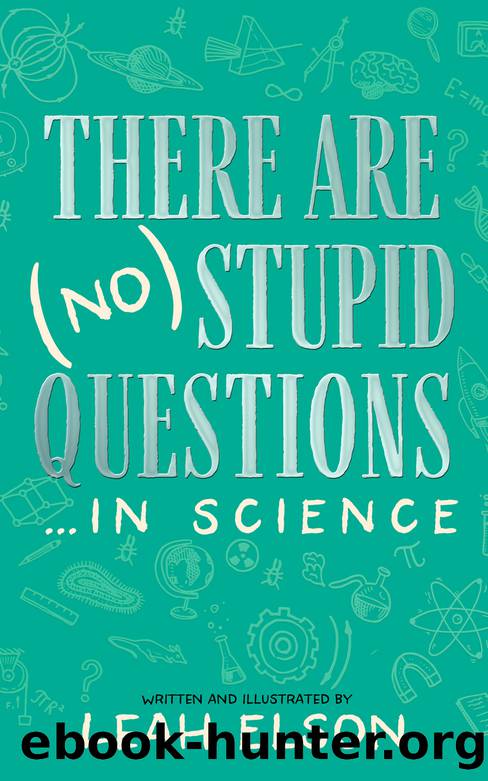There Are (No) Stupid Questions ... in Science by Leah Elson

Author:Leah Elson
Language: eng
Format: epub
Publisher: Blackstone Publishing
Published: 2023-05-24T00:07:23+00:00
How are all the colors of the rainbow contained in white light?
I totally understand the undertones of outrage when this question is asked. If youâve had a cursory encounter with mixing paint colors, then you know that the combination of even a few of them can result in a drab muddy-brown hue. So itâs only naturalâbased on our firsthand finger-painting adventuresâto be confused when weâre told that white light contains all the colors in our perceived visible spectrum. Shouldnât the light, instead, be icky brown?
I find it best to begin with the basics, so letâs talk about the nature of white light. The light we perceive is also aptly called âvisible lightâ and is part of the electromagnetic spectrum. It corresponds to wavelengths of radiation that fall in the middle of this spectrum, somewhere between super powerful gamma rays and long lumbering radio waves. Therefore, visible light is simply radiation that we have developed sensory receptors to be able to see. Some animals have gone a step further and can also visualize radiation in the ultraviolet or infrared parts of the electromagnetic spectrum as well.
Our range of visible light includes a multitude of frequencies. Human brains have been wired to interpret each of these frequencies as a distinct hue. So color can be perceived when any of these frequencies enter the eye.
Letâs consider a strawberry. The reason we see its bright color is because molecules in the skin of the strawberry have reflected a frequency of visible radiation that corresponds to the color red. The radiation bounces off the strawberry, enters our eye, and triggers a cascade of signaling to the brain, and the brain says, âYep, thatâs red.â We donât see the strawberry as blue or purple or green because those frequencies were absorbed by the strawberryâs skin and, as such, never entered our eye for interpretation by the brain.
White light is what light looks like when none of the frequencies are being reflected or absorbed, and theyâre all still packaged together. Remember: when photoreceptors of the eye are not being activated, the brain cannot interpret a distinct color. So the light is called âwhite.â But more accurately, itâs not really white as much as it is a non-photoreceptor-activating, colorless beam of electromagnetic radiation. If certain wavelengths arenât bouncing off objects, then you wonât perceive an associated color.
Now, letâs circle back to the frustrations of mixing paints. The reason multiple colors of paint will yield icky brown is that multiple combined pigments will reflect different frequencies of light into your eyes, simultaneously, for a combined interpretation. And this combined interpretation, with the unchecked paint-mixing bravado of a novice, is usually quite hideous.
Download
This site does not store any files on its server. We only index and link to content provided by other sites. Please contact the content providers to delete copyright contents if any and email us, we'll remove relevant links or contents immediately.
Alchemy and Alchemists by C. J. S. Thompson(3448)
The Elements by Theodore Gray(2997)
The Club by A.L. Brooks(2862)
How to Make Your Own Soap by Sally Hornsey(2826)
Drugs Unlimited by Mike Power(2545)
Wheels of Life by Anodea Judith(2096)
Cracking the LSAT, 2012 Edition by Princeton Review(1880)
Cracking the Sat French Subject Test, 2013-2014 Edition by The Princeton Review(1828)
Perfume by Jean-Claude Ellena(1781)
The Flavor Matrix by James Briscione(1774)
The Cosmic Machine: The Science That Runs Our Universe and the Story Behind It by Scott Bembenek(1725)
MCAT Physics and Math Review by Princeton Review(1636)
1000 Multiple-Choice Questions in Organic Chemistry by Organic Chemistry Academy(1621)
The Thing Around Your Neck by Chimamanda Ngozi Adichie(1600)
Handbook of Modern Sensors by Jacob Fraden(1544)
Cracking the SAT Premium Edition with 6 Practice Tests, 2017 by Princeton Review(1535)
Synchrotron Light Sources and Free-Electron Lasers by Eberhard J. Jaeschke Shaukat Khan Jochen R. Schneider & Jerome B. Hastings(1524)
A is for Arsenic: The Poisons of Agatha Christie (Bloomsbury Sigma) by Kathryn Harkup(1507)
Harry Potter All Books: 8 Books by J.k.rowling(1492)
